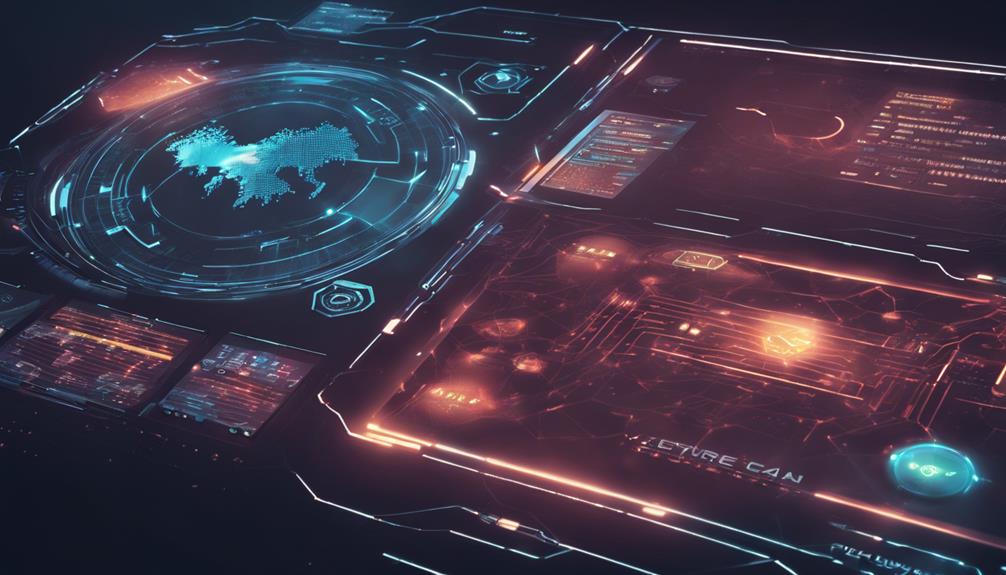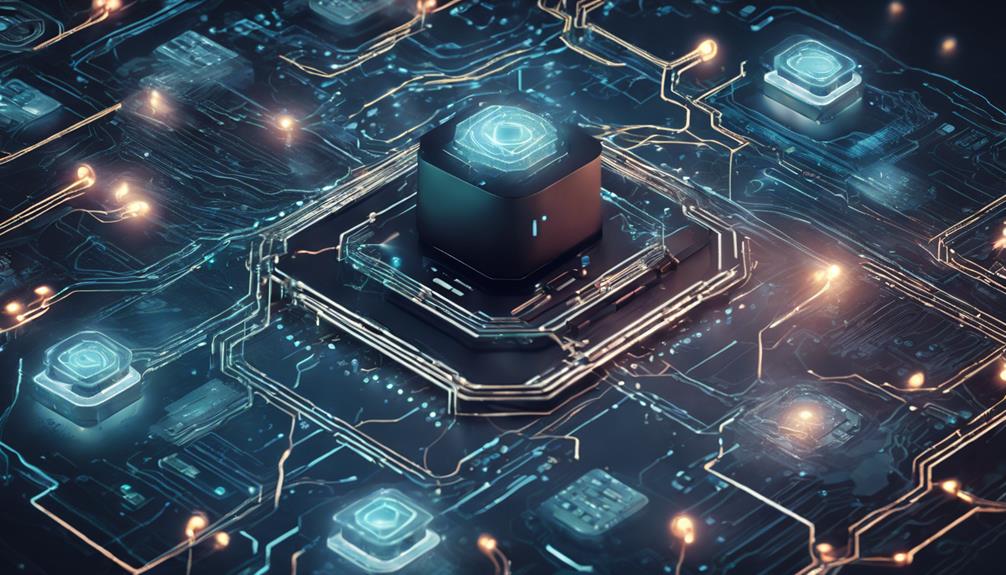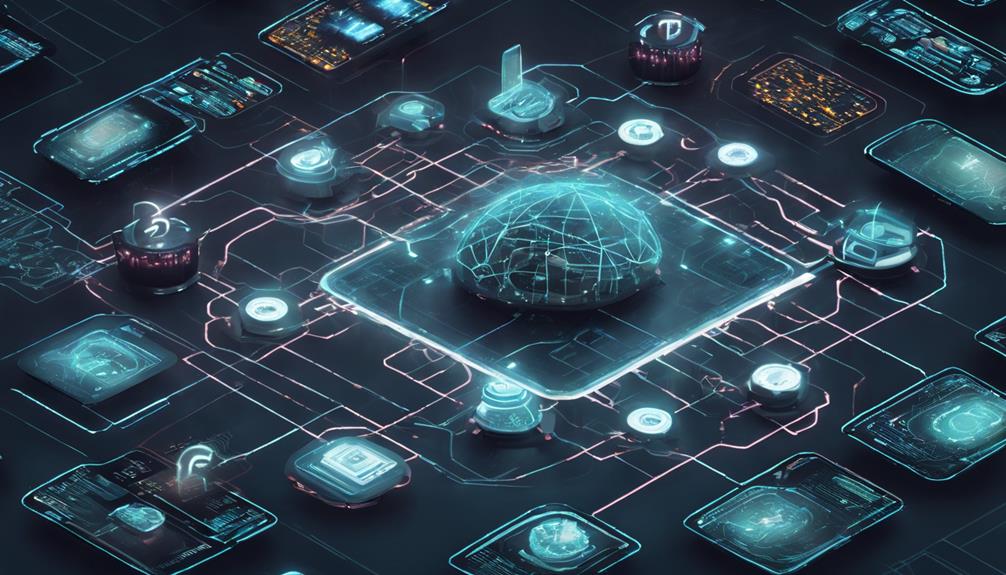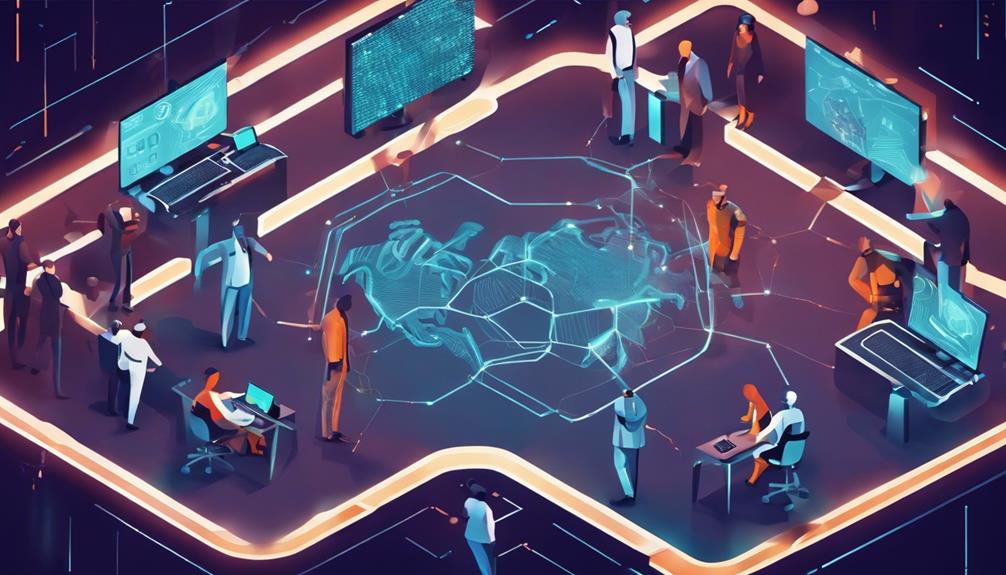The future of cybersecurity is closely intertwined with AI advancements, where AI-driven defense systems are reshaping threat detection and response strategies. Machine learning algorithms are enhancing security measures, predicting threats accurately. Collaboration among organizations is essential to maximize AI's potential. Ethical AI practices guarantee transparency and fairness in algorithms, complying with regulations like GDPR. Automation tools streamline processes, reducing incident response times greatly. AI is instrumental in proactive threat detection, with collective threat intelligence fortifying defense mechanisms. Future trends predict a surge in AI-powered security tools' adoption, revolutionizing cybersecurity. Learn more about these exciting developments shaping the future of AI in cybersecurity.
Key Takeaways
- Machine learning boosts threat detection capabilities.
- 60% of enterprises to adopt AI security tools by 2024.
- AI-driven threat intelligence platforms on the rise.
- Predicted 99% threat detection rate by 2025.
- Threat intelligence market value to hit $1.8 billion by 2026.
AI Evolution in Cybercrime
As cybercriminals advance their techniques, the evolution of AI in cybercrime has noticeably transformed the landscape of cybersecurity defense strategies.
The emergence of AI-driven malware has ushered in a new era where malicious actors can adapt in real-time, exploiting vulnerabilities and circumventing traditional security measures with alarming efficiency.
Additionally, phishing attacks have taken on a more insidious form, with AI-generated messages personalized to deceive individuals, making them harder to detect and resist.
This escalation in utilizing AI by malicious actors has greatly heightened the complexity of cyber threats, creating a formidable challenge for defenders in the cybersecurity landscape.
The prevalence of AI-powered attacks has initiated an arms race where defenders must continuously innovate to counter these evolving threats effectively.
Understanding the impact of AI in cybercrime is vital for organizations to fortify their defenses and stay ahead in safeguarding against sophisticated cyber threats.
AI Defense Systems

AI defense systems play a pivotal role in bolstering cybersecurity by leveraging predictive capabilities to anticipate, prevent, and mitigate cyber threats in real-time. These systems utilize advanced machine learning algorithms to enhance threat detection accuracy, enabling organizations to implement proactive security measures effectively.
By harnessing AI-powered incident response and predictive analytics, businesses can identify vulnerabilities and address them before they are exploited by cyber attackers.
However, maintaining the integrity and effectiveness of AI defense systems requires regular audits and updates to adapt to evolving threats. Collaboration and knowledge-sharing among organizations are also vital in maximizing the potential of AI in strengthening cybersecurity defenses.
As the landscape of cybersecurity challenges continues to evolve, strategic initiatives focused on AI security are essential for staying ahead of malicious actors and safeguarding sensitive data. Embracing AI defense systems with a proactive mindset is key to building robust cybersecurity frameworks in the face of persistent threats.
Leveraging AI for Security Enhancement

AI technology is revolutionizing cybersecurity by enhancing threat detection, automating incident response, and implementing adaptive security measures.
With the majority of IT decision-makers recognizing the value of AI-driven security solutions, organizations are investing in machine learning algorithms to scan infrastructure for vulnerabilities efficiently.
AI-Powered Threat Detection
Utilizing advanced artificial intelligence technology for threat detection has revolutionized cybersecurity practices, enabling organizations to proactively monitor and respond to security incidents in real-time.
AI-powered threat detection plays a pivotal role in identifying and mitigating risks posed by bad actors who exploit generative AI for malicious activities.
Through the use of sophisticated machine learning algorithms, AI systems scan infrastructure to uncover vulnerabilities and weaknesses that could be potential entry points for cyber threats.
Automated Incident Response
In addition, notably, AI-driven systems excel in analyzing and prioritizing security alerts, leading to a remarkable reduction in false positives by up to 70%.
Organizations embracing AI for incident response witness a remarkable 50% faster resolution of security incidents. Additionally, AI plays a pivotal role in automating threat containment, remediation, and recovery processes, ultimately fortifying the overall cybersecurity posture.
One of the key benefits of leveraging AI for incident response is the capability to efficiently handle a higher volume of security incidents. By harnessing the power of AI in incident response, organizations can greatly enhance their ability to detect, respond to, and recover from cybersecurity threats swiftly and effectively.
The future of cybersecurity lies in the seamless integration of automated incident response systems powered by AI, paving the way for a more secure digital landscape.
Adaptive Security Measures
Enhancing cybersecurity defenses through the integration of adaptive security measures leverages the power of artificial intelligence to proactively detect and respond to evolving cyber threats in real-time.
By deploying AI-driven adaptive security measures, organizations can greatly enhance their incident response times and overall cybersecurity posture. Machine learning algorithms play a vital role in this process by continuously analyzing vast amounts of data to identify anomalies and improve threat detection accuracy.
These proactive security measures not only detect cyber threats but also predict potential attack vectors before they are exploited, providing a proactive defense strategy.
Moreover, the automation of time-consuming security tasks through AI-driven defenses enables IT professionals to focus on more strategic initiatives, further strengthening the organization's security posture.
Collaborative efforts between AI systems and cybersecurity teams create a synergy that bolsters defense mechanisms against the constantly evolving landscape of cyber threats, ensuring a robust and responsive cybersecurity framework.
Ethical AI Use in Cybersecurity

Ensuring transparency and fairness in AI algorithms is vital in maintaining ethical standards in cybersecurity to mitigate bias and discrimination risks. Responsible AI practices in cybersecurity emphasize the importance of data privacy and security to uphold ethical standards in AI deployment.
By addressing algorithm bias and promoting inclusivity, ethical AI use in cybersecurity can maintain trust and integrity within the industry. Guidelines focusing on accountability and explainability are essential to prevent malicious use of AI and uphold ethical standards.
Compliance with regulations like GDPR and following ethical frameworks such as IEEE's Ethically Aligned Design are critical steps in ensuring ethical AI use in cybersecurity. By prioritizing these aspects, the cybersecurity industry can foster a culture of responsible AI use that respects user privacy, promotes fairness, and works towards a more inclusive and ethical technological landscape.
Automation in Cybersecurity

Automation plays a pivotal role in cybersecurity by revolutionizing threat detection and incident response capabilities. AI automation tools enable real-time threat detection, reducing incident response times by a substantial margin. These tools can process over 1 million security events per second, enhancing efficiency and accuracy in identifying potential threats. By leveraging machine learning algorithms, organizations can automate threat identification, leading to proactive defense strategies against cyber threats.
Additionally, automated threat response systems powered by AI can greatly reduce incident response times from hours to milliseconds, bolstering overall cybersecurity resilience.
Furthermore, cybersecurity automation not only improves response times but also helps in saving up to 70% on security operation costs through streamlined processes. Embracing AI-driven automation in cybersecurity is essential for organizations looking to stay ahead of evolving threats in the digital landscape. By integrating automated tools and systems into their cybersecurity frameworks, businesses can bolster their defenses and respond swiftly to emerging cyber risks.
Collaborative AI Security Measures

Collaborative AI security measures revolutionize threat detection by combining the power of artificial intelligence with human insights. Through AI for threat detection, organizations can harness collective threat intelligence to anticipate and combat sophisticated cyber threats effectively.
This collaborative approach guarantees a proactive stance against evolving cybersecurity challenges, enhancing overall defense strategies.
AI for Threat Detection
How can AI systems collaborate with human experts to enhance threat detection and response in cybersecurity?
Collaborative AI security measures combine the strengths of AI systems and human oversight to create a robust defense against cyber threats.
Here are three key ways in which AI for threat detection enhances cybersecurity:
- Proactive Cybersecurity: Collaborative AI security allows for the proactive identification of potential cyber threats by analyzing vast amounts of data in real-time. This proactive approach helps security teams stay ahead of emerging risks.
- Automation of Tasks: AI-driven tools automate time-consuming tasks, such as data analysis and pattern recognition, enabling IT professionals to focus on more complex security challenges that require human intervention.
- Enhanced Decision-Making: Human oversight plays an important role in collaborative AI security by providing context and decision-making capabilities that AI systems may lack. This collaboration ensures that the right actions are taken to mitigate threats effectively.
Collective Threat Intelligence
In the domain of cybersecurity, the integration of collective threat intelligence through collaborative AI security measures presents a vital advantage in fortifying defense mechanisms against evolving cyber threats. By embracing shared threat intelligence in AI cybersecurity, organizations can enhance their cybersecurity defenses by leveraging insights from multiple sources.
This collaboration enables quicker identification and mitigation of cyber threats, ultimately strengthening overall defense strategies. Predicting and preventing future cyber attacks becomes more effective with the power of collective AI security measures.
Through pooling resources and knowledge, organizations can proactively stay ahead of evolving cyber threats and trends. Embracing this trend of collaboration in cybersecurity not only enhances individual organization's defenses but also contributes to the collective resilience of the cybersecurity ecosystem.
As the landscape of cyber threats continues to evolve, the adoption of collective threat intelligence stands out as an essential component in the ongoing battle for cyber defense.
Addressing Cyber Threats With AI

Utilizing artificial intelligence in cybersecurity is revolutionizing the approach to addressing and mitigating cyber threats in today's digital landscape. AI in cybersecurity accelerates threat detection and response times by automating processes, allowing for swift identification and containment of potential security breaches.
Machine learning algorithms play an essential role in analyzing historical data to create predictive models, enabling organizations to anticipate and prevent future cyber threats proactively. Additionally, AI tools enhance security measures by detecting anomalies and guarding against sophisticated cyber attacks through behavioral analysis.
Furthermore, AI strengthens access control and authentication measures by integrating advanced techniques like biometric authentication, ensuring a robust defense against unauthorized access attempts. By leveraging AI-driven technologies in cybersecurity, organizations can significantly improve their security posture and stay ahead of evolving cyber threats in an increasingly complex digital environment.
Future AI Trends in Cybersecurity

The evolution of artificial intelligence (AI) in cybersecurity is paving the way for transformative advancements in safeguarding digital assets against emerging threats. As the technology landscape continues to evolve, several future trends are shaping the field of AI in cybersecurity. Machine learning algorithms are predicted to play a crucial role in enhancing cyber threat detection capabilities, with expectations to detect 99% of cyber threats by 2025. Additionally, AI-driven security tools are projected to become mainstream, with a forecast that 60% of enterprises will adopt AI-powered security tools by 2024, marking a significant increase from 7% in 2020. Threat intelligence platforms leveraging AI are also on the rise, with market value expected to reach $1.8 billion by 2026. However, challenges lie ahead, as generative AI poses a growing concern, with 68% of security professionals anticipating a rise in AI-powered threats. The integration of AI in cybersecurity is set to revolutionize the industry, offering enhanced protection against sophisticated cyber threats.
| Future Trends in AI Cybersecurity | ||
|---|---|---|
| Machine Learning Algorithms | AI-driven Security Tools | Threat Intelligence Platforms |
| Predicted to detect 99% of threats by 2025 | Expected adoption by 60% of enterprises by 2024 | Market value to reach $1.8 billion by 2026 |
Frequently Asked Questions
What Is the Future of AI in Cyber Security?
AI's future in cybersecurity is promising, with its ability to automate threat detection, enhance threat intelligence, and strengthen access control. Investments in AI-driven cybersecurity solutions are expected to increase, providing advanced protection against evolving cyber threats.
How Will Artificial Intelligence Affect Cybersecurity in 2024 and Beyond?
How will artificial intelligence affect cybersecurity in 2024 and beyond? With the ever-evolving cyber threat landscape, AI will continue to play a pivotal role in enhancing anomaly detection, strengthening defenses, and enabling proactive cybersecurity strategies for organizations worldwide.
What Is Predictive AI in Cyber Security?
Predictive AI in cybersecurity leverages historical data and machine learning algorithms to anticipate potential cyber threats before they manifest. It enhances threat intelligence by identifying patterns, anomalies, and vulnerabilities, enabling proactive risk mitigation and real-time incident response.
What Will Be the Future of AI in Coming Future?
In the coming future, AI will revolutionize cybersecurity by exponentially enhancing threat detection capabilities, fortifying defenses against evolving cyber threats, and notably reducing response times to attacks. Its impact will be unparalleled in safeguarding digital assets.
Conclusion
To wrap up, the future of AI in cybersecurity holds great promise for both defending against cyber threats and enhancing overall security measures.
As technology continues to evolve, the integration of AI systems will play a vital role in safeguarding against increasingly sophisticated cybercrime tactics.
Are you ready to embrace the power of AI to protect against cyber threats and secure a digital future?









